Nabh4 - Study guides, Class notes & Summaries
Looking for the best study guides, study notes and summaries about Nabh4? On this page you'll find 74 study documents about Nabh4.
Page 2 out of 74 results
Sort by

-
Organic Chemistry ACS Final Exam Questions With Correct Verified Solutions A+ Graded
- Exam (elaborations) • 5 pages • 2024
-
- $10.49
- + learn more
Organic Chemistry ACS Final Exam Questions With Correct Verified Solutions A+ Graded Basicity rules - ANS -strong base: unstable/reactive (ED groups) -weak base: stable (EW groups/more EN/bigger) Chair conformation - ANS -more stable equatorial (slanted) -pointing up/pointing down=cis if both up -elimination: trans and diaxial Newman projection - ANS -gauche: substituent groups adjacent to each other -grab middle and turn to put in plane Enantiomers - ANS -not superimpos...
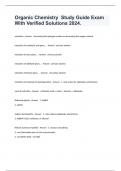
-
Organic Chemistry Study Guide Exam With Verified Solutions 2024.
- Exam (elaborations) • 4 pages • 2024
-
Available in package deal
-
- $9.79
- + learn more
reduction - Answer increasing the hydrogen content or decreasing the oxygen content reduction of carboxylic acid gives... - Answer primary alcohol reduction of ester gives... - Answer primary alcohol reduction of aldehyde gives... - Answer primary alcohol reduction of ketone gives... - Answer secondary alcohol reduction of carbonyls by hydrogenation - Answer 1. only works for aldehydes and ketones ease of reduction - Answer carboxylic acids < esters < ketone...
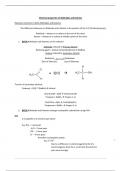
-
Chemical properties of Aldehydes and Ketones
- Exam (elaborations) • 45 pages • 2024
-
- $12.49
- + learn more
Chemical properties of Aldehydes and Ketones Reactions common to both Aldehydes and Ketones The difference between an Aldehyde and a Ketone is the position of the C=O (Carbonyl group). Aldehyde – always on a carbon at the end of the chain Ketone – Always on a carbon at middle carbon of the chain 1. BOTH Aldehydes and Ketones can be reduced Aldehyde reduced to Primary Alcohol Reducing agent = Sodium tetrahydroborate III (NaBH4) Ketone reduced to Secondary Alcohol Reduction Oxidisatio...

-
MCAT Organic Chemistry Questions and Answers | Latest Update | 2024/2025 | 100% Verified
- Exam (elaborations) • 50 pages • 2024
-
Available in package deal
-
- $12.38
- + learn more
MCAT Organic Chemistry Questions and Answers | Latest Update | 2024/2025 | 100% Verified What is the product of the oxidation of a primary alcohol? The product is an aldehyde. Further oxidation yields a carboxylic acid. What is the primary reagent used for the reduction of ketones to secondary alcohols? The primary reagent is sodium borohydride (NaBH4) or lithium aluminum hydride (LiAlH4). What is the characteristic reaction of a carboxylic acid with an amine? The reaction ...
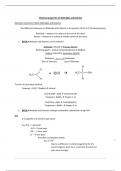
-
Chemical properties of Aldehydes and Ketones
- Exam (elaborations) • 45 pages • 2024
-
- $10.99
- + learn more
Chemical properties of Aldehydes and Ketones Reactions common to both Aldehydes and Ketones The difference between an Aldehyde and a Ketone is the position of the C=O (Carbonyl group). Aldehyde – always on a carbon at the end of the chain Ketone – Always on a carbon at middle carbon of the chain 1. BOTH Aldehydes and Ketones can be reduced Aldehyde reduced to Primary Alcohol Reducing agent = Sodium tetrahydroborate III (NaBH4) Ketone reduced to Secondary Alcohol Reduction Oxidisation ...

-
Chemical properties of Aldehydes and Ketones Reactions common to both Aldehydes and Ketones
- Exam (elaborations) • 45 pages • 2024
-
- $11.49
- + learn more
Chemical properties of Aldehydes and Ketones Reactions common to both Aldehydes and Ketones The difference between an Aldehyde and a Ketone is the position of the C=O (Carbonyl group). Aldehyde – always on a carbon at the end of the chain Ketone – Always on a carbon at middle carbon of the chain 1. BOTH Aldehydes and Ketones can be reduced Aldehyde reduced to Primary Alcohol Reducing agent = Sodium tetrahydroborate III (NaBH4) Ketone reduced to Secondary Alcohol Reduction Oxidisatio...

-
OCR A Level Organic & Organic synthesis Chemistry Exam 2024 with Guaranteed Accurate Answers
- Exam (elaborations) • 10 pages • 2024
-
- $14.59
- + learn more
Alkene + hydrogen /nickel catalyst/423K= - correct answer alkane Alkene + bromine /room temperature= - correct answer dihaloalkane Alkene + HCl(g/aq) /room temperature= - correct answer haloalkane (mixed products) Alkene + H2O(g) /H3PO4= - correct answer alcohol (mixed products) Primary alcohol + 2[O] /excess K2Cr2O7/H2SO4/reflux= - correct answer carboxylic acid Primary alcohol + [O] /K2Cr2O7/H2SO4/distil= - correct answer aldehyde Secondary alcohol + [O] /K2Cr2O7/H2SO4/reflux...
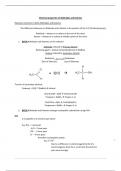
-
Chemical properties of Aldehydes and Ketones
- Exam (elaborations) • 45 pages • 2024
-
- $17.99
- + learn more
Chemical properties of Aldehydes and Ketones Reactions common to both Aldehydes and Ketones The difference between an Aldehyde and a Ketone is the position of the C=O (Carbonyl group). Aldehyde – always on a carbon at the end of the chain Ketone – Always on a carbon at middle carbon of the chain 1. BOTH Aldehydes and Ketones can be reduced Aldehyde reduced to Primary Alcohol Reducing agent = Sodium tetrahydroborate III (NaBH4) Ketone reduced to Secondary Alcohol Reduction Oxidisatio...
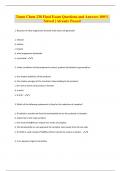
-
Tamu Chem 238 Final Exam Questions and Answers 100% Solved | Already Passed
- Exam (elaborations) • 25 pages • 2024
- Available in package deal
-
- $8.49
- + learn more
1. Reaction of ethyl magnesium bromide with water will generate? a. ethanol b. ethane c. butane d. ethyl magnesium hydroxide e. a peroxide - b 2. Under conditions of thermodynamic control, product distribution is governed by: a. the relative stabilities of the products b. the relative energies of the transition states leading to the products c. the rate at which each product is formed d. a and b e. b and c - a 3. Which of the following statements is false for the reduction of camphor...

-
Organic Chemistry ACS Final (with Complete Solutions) 2024.
- Exam (elaborations) • 5 pages • 2023
-
Available in package deal
-
- $10.99
- + learn more
Basicity rules correct answers -strong base: unstable/reactive (ED groups) -weak base: stable (EW groups/more EN/bigger) Chair conformation correct answers -more stable equitorial (slanted) -pointing up/pointing down=cis if both up -elimination: trans and diaxial Newman projection correct answers -gauche: substituent groups adjacent to eachother -grab middle and turn to put in plane Enantiomers correct answers -not superimposable mirror images -same besides stereochemistry Diast...

$6.50 for your textbook summary multiplied by 100 fellow students... Do the math: that's a lot of money! Don't be a thief of your own wallet and start uploading yours now. Discover all about earning on Stuvia


